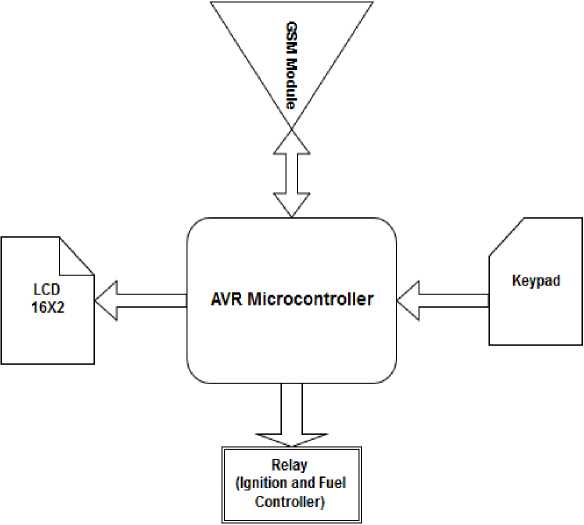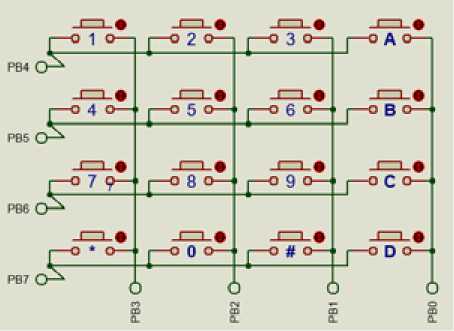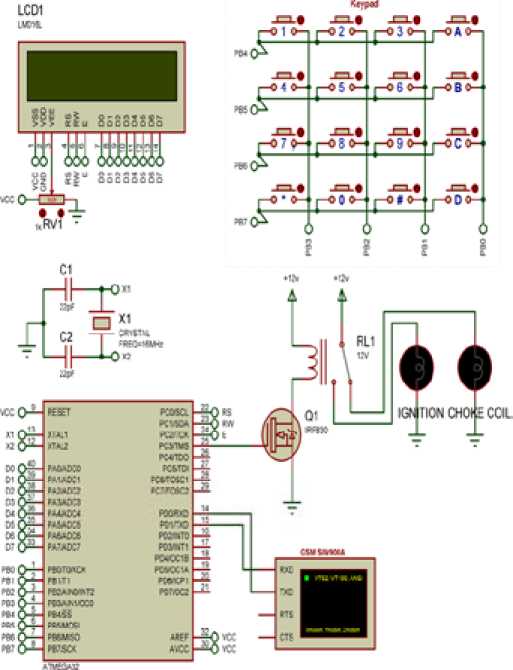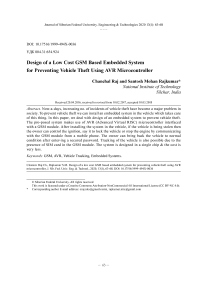Design of a low cost GSM based embedded system for preventing vehicle theft using AVR microcontroller
Автор: Raj Chanchal, Rajkumar Santosh Mohan
Журнал: Журнал Сибирского федерального университета. Серия: Техника и технологии @technologies-sfu
Статья в выпуске: 1 т.13, 2020 года.
Бесплатный доступ
Now-a-days, increasing no. of incidents of vehicle theft have become a major problem in society. To prevent vehicle theft we can install an embedded system in the vehicle which takes care of this thing. In this paper, we deal with design of an embedded system to prevent vehicle theft. The pro-posed system makes use of AVR (Advanced Virtual RISC) microcontroller interfaced with a GSM module. After installing the system in the vehicle, if the vehicle is being stolen then the owner can control the ignition, say it to lock the vehicle or stop the engine by communicating with the GSM module from a mobile phone. The owner can bring back the vehicle to normal condition after enter-ing a secured password. Tracking of the vehicle is also possible due to the presence of SIM card in the GSM module. The system is designed in a single chip & the cost is very less.
Gsm, avr, vehicle tracking, embedded systems
Короткий адрес: https://sciup.org/146281420
IDR: 146281420 | УДК: 004.31:654.924 | DOI: 10.17516/1999-494X-0036
Текст научной статьи Design of a low cost GSM based embedded system for preventing vehicle theft using AVR microcontroller
-
1. Introduction
In recent years, vehicle thefts are increasing at an alarming rate around the world. According to National Crime Information Center (NCIC), in 2006, 1,192,809 motor vehicles were reported stolen, the losses were 7.9$ billion [1]. People have started to use the theft preventing systems installed in their vehicles. The commercially available anti-theft vehicular systems are very expensive. Therefore in this paper we propose a simple low cost embedded system to serve this purpose. The embedded system block consist of an AVR microcontroller, GSM module, LCD, keypad, relay circuitry, power supply unit.
GSM (Global System for Mobile Communications, originally Groupe Spécial Mobile), is a standard developed by the European Telecommunications Standards Institute (ETSI) to describe the protocols for second-generation (2G) digital cellular networks used by mobile phones, first deployed in Finland in July 1991. As of 2014 it has become the default global standard for mobile communications – with over 90% market share, operating in over 219 countries and territories. The network structure of GSM is divided into a number of discrete sections as follows [7]:
-
• Base Station Subsystems (the base stations & their controllers).
-
• Network and Switching Subsystem (the part of the network most similar to a fixed network, sometimes just called the “core network”.
-
• GPRS Core Network (the optional part which allows packet-based Internet connections).
-
• Operations support system (OSS) (network maintenance).
-
2. The designed embedded system
-
A. The AVR microcontroller
The heart of the system lies in the AVR microcontroller, which handles all signals. It is an 8-bit microcontroller which works on 16 MHz crystal frequency. The version of AVR we are using here is ATmega32 by atmel. The key features of ATmega32 are:
-
• High-performance, Low-power consumption.
-
• Advanced RISC architecture.
-
• High endurance non-volatile memory segments.

-
• JTAG (IEEE std. 1149.1 Compliant) interface.
The pin configuration of ATmega32 is shown below in Fig. 2.
-
B. The keypad
-
C. The display unit
-
D. The relay unit
The relay we are using here is driven by Power MOSFET (IRF830) and we apply the output of AVR microcontroller to the gate of MOSFET. The MOSFET is biased by 12V supply from the battery.
PDIP
|
(XCK/TO) РВО с |
1 40 |
J РАО (ADCO) |
|
(Т1) РВ1 с |
2 39 |
□ РА1 (ADC1) |
|
(INT2/AIN0) РВ2 Е |
3 38 |
□ РА2 (ADC2) |
|
(0CO/AIN1) РВЗ С |
4 37 |
□ РАЗ (ADC3) |
|
(SS) Р84 г- |
5 36 |
□ РАД (ADC4) |
|
(MOSI) РВ5 Г |
6 35 |
□ РА5 (ADC5) |
|
(MISO) РВ6 с |
7 34 |
□ РА6 (ADC6) |
|
(SCK) РВ7 С |
8 33 |
□ РА7 (ADC7) |
|
RESET с |
9 32 |
□ AREF |
|
VCC с |
10 31 |
□ GND |
|
GND С |
11 30 |
□ AVCC |
|
XTAL2 С |
12 29 |
□ РС7 (TOSC2) |
|
XTAL1 С |
13 28 |
□ РС6 (TOSC1) |
|
(RXD) POO Е |
14 27 |
0 PCS (TDI) |
|
(TXD) PD1 Г |
15 26 |
J PC4 (TDO) |
|
(INTO) PD2 Е |
16 25 |
□ PC3 (TMS) |
|
(INT1) РОЗ Е |
17 24 |
□ PC2 (TCK) |
|
(0018) PD4 Е |
18 23 |
□ PC1 (SDA) |
|
(ОС1А) PD5 Е |
19 22 |
□ PCO (SOL) |
|
(ICP1) PD6 Е |
20 21 |
□ PD7 (002) |

Fig. 3. The Designed Keypad
-
E. The gsm module
We are using SIM900A GSM module with GSM/GPRS which works on frequency 900/1800 MHz. The receiver (Rx) pin of GSM module is connected to Tx (pin 15) of microcontroller & transmit (Tx) pin of GSM module is connected to Rx (pin 14) of microcontroller. The default baud rate of both module & microcontroller is 9600. The GSM module communicates with the microcontroller serially as per UART (Universal Asynchronous Receive Transmit) protocol. The signal of module contains Data Bits: 8, Parity: none, Stop Bit: 1. The frequency & baud rate can be modified using AT command.
-
3. The schematic simulated hardware design
-
4. Conclusion

Fig. 4. Simulation Schematic of the embedded system
Список литературы Design of a low cost GSM based embedded system for preventing vehicle theft using AVR microcontroller
- Ramadan M., Al-Khedher M. and Al-Kheder S. Intelligent anti-theft and tracking system for automobiles, Int. J. Mach. Learn. Comput, 2012, 2(1), 83-88.
- Asaad M.J. Al-Hindawi, Ibraheem Talib. Experimentally Evaluation of GPS/GSM Based System Design, Journal of Electronic Systems, 2012, 2(2).
- Zhai Guorui and Dai Shenghua. Design of auto guard against theft system based on GPRS and GPS. Microcontrollers and Embedded Systems, Bei Jing, 2007, 8: 39-41.
- Xavier Lagrange, Philippe Godlewski, Sami Tabbane. GSM network and GPRS. Beijing: Electronic Industry Press. 2002.
- Pravada P. Wankhade and Prof. S.O. Dahad. Real Time Vehicle Locking and Tracking System using GSM and GPS Technology-An Anti-theft System, International Journal of Technology And Engineering System, 2011, 2(3).
- Sehgal V.K., Singhal M., Mangla B., Singh, S., Kulshrestha S. An Embedded Interface for GSM Based Car Security System, IEEE Conference, 2012 Fourth International Conference on , Computational Intelligence, Communication Systems and Networks (CICSyN), 2012. DOI: 10.1109/CICSyN..12.
- en.wikipedia.org


